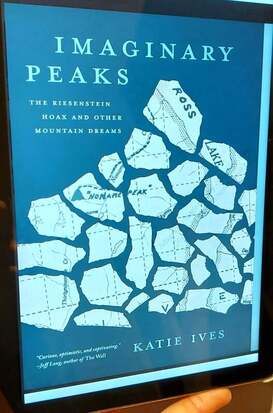
Once you begin to look for imaginary peaks, you start to see them everywhere: each furrow of crag and hill has its own local myths; each square of map conceals forgotten phantom heights. Each human mind contains innumerable ranges, sparkling like starlight and like snow.
I was so excited to read this; Katie Ives’ writing is always stunning, and this book had me hooked right from the title. Imaginary Peaks is an intriguing exploration of the fascination held by empty spaces on the map, and of mountains that aren’t represented on maps. Mountaineering has always felt otherwordly to me, lingering somehow right on the edge between reality and a vivid fantasy. There have been moments in the mountains that I’ve later struggled to explain and I’ve always been frustrated by what feels like a huge inability to re-tell my own experiences, so I felt very comforted (and validated!) by Katie’s discussion of the sheer difficulty of fully capturing our experiences in the mountains, let alone the impossibility of trying to pin down such vivid and complex terrain onto a flat piece of paper.
The first section races through stories about peaks which have been imagined or hallucinated or confused; a mis-history of discoveries and exploration. There’s a long list of intentional and accidental reports of summits later found not to exist. It’s incredible to think about how quickly and relatively recently our knowledge of the world has been put together – it wasn’t really that long ago that explorers were genuinely (if willingly) bewildered by towering peaks which were later established as vivid tricks of light and cloud. There’s a lot of short anecdotes in the first half, quick recaps of expeditions which I would happily have read a whole book about. It covers a huge scope of explorers and expeditions and pulls from an impressive amount of research, although I did occasionally find the pace of the narrative a little confusing.
The second half focuses more on the life of Harvey Manning and the hoaxes he manages to pull off within the climbing community. Harvey’s reflections on appreciating the small beauties in the landscape, taking the time to stop and observe it all, felt very apt in our post-lockdown world. I also enjoyed Katie’s honest reflections on the reality of trying to identify hoaxes as a magazine editor and the difficulties of ever knowing the full truth about an ascent. The ambiguity seems to be a huge part of the draw of mountaineering literature; the world that top alpinists are operating in is so far removed from our everyday lives that it really does become impossible to ever fully know what happened at 8,000 metres – sometimes even impossible for the climbers themselves to understand events or be sure that they reached the correct summit. Katie writes with sensitivity and awareness throughout, and she’s always quick to acknowledge the rights of indigenous people who are often already living in the lands westerners claim to explore. The real value of the book, for me, was the delight in finding a moment of genuine exploration when maps turn out to be false, and the discussion around how every hoax shows us something about our own perception and understanding of these mysterious places. I’m so grateful that some aspect of the mountains will always remain a mystery – the magic of the unknown is definitely part of the draw of mountaineering for me. Imaginary Peaks left me with many wandering questions about the purpose and truth of maps, and about the necessity – or not – of being able to match the land in front of me to what’s on the piece of paper in my hand. All maps, in the end, will always be imaginary. (With thanks to Mountaineers Books for a free e-copy in exchange for an honest review.)
0 Comments
Leave a Reply. |
book REVIEWSPredominantly climbing/outdoors literature, mountaineering history and nature writing. Archives
July 2023
Categories
All
|
 RSS Feed
RSS Feed


